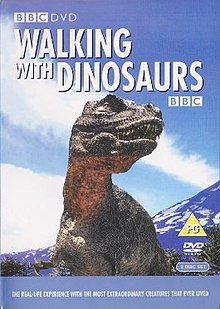| Walking with Dinosaurs | |
|---|---|
 Cover of a 2004 UK DVD release | |
| Genre | Nature documentary |
| Created by | Tim Haines[1] Susan Spindler[2][3] |
| Directed by | Tim Haines Jasper James |
| Creative director | Mike Milne |
| Narrated by | Kenneth Branagh Avery Brooks (US) Ben Stiller (Prehistoric Planet) |
| Composer | Ben Bartlett |
| Country of origin | United Kingdom |
| Original language | English |
| No. of episodes | 6 (+3 special) |
| Production | |
| Executive producer | John Lynch |
| Producers | Tim Haines Jasper James |
| Cinematography | John Howarth Michael Pitts |
| Editor | Andrew Wilks |
| Running time | 30 minutes |
| Production company | BBC Science Unit[4] |
| Budget | £6.1 million[5] |
| Original release | |
| Network | BBC One |
| Release | 4 October – 8 November 1999 |
| Infobox instructions (only shown in preview) | |
Walking with Dinosaurs is a 1999 six-part nature documentary television miniseries created by Tim Haines and produced by the BBC Science Unit, the Discovery Channel and BBC Worldwide, in association with TV Asahi, ProSieben and France 3. Envisioned as the first "Natural History of Dinosaurs", Walking with Dinosaurs depicts dinosaurs and other Mesozoic animals as living animals in the style of a traditional nature documentary. The series first aired on the BBC in the United Kingdom in 1999 with narration by Kenneth Branagh.[6] The series was subsequently aired in North America on the Discovery Channel in 2000, with Avery Brooks replacing Branagh.
Walking with Dinosaurs recreated extinct species through the combined use of computer-generated imagery and animatronics that were incorporated with live action footage shot at various locations, the techniques being inspired by the film Jurassic Park (1993). At a cost of £6.1 million ($9.9 million), Walking with Dinosaurs cost over £37,654 ($61,112) per minute to produce, making it the most expensive documentary series per minute ever made.[5] The visual effects of the series were initially believed to be far too expensive to produce, but innovative techniques by the award-winning graphics company Framestore made it possible to bring down costs sufficiently to produce the three-hour series.
With 15 million people viewing the first airing of the first episode, Walking with Dinosaurs was by far the most watched science programme in British television during the 20th century.[7] The series received critical acclaim and won numerous awards, including two BAFTA Awards, three Emmy Awards and a Peabody Award. Most scientists applauded Walking with Dinosaurs for its use of scientific research and for its portrayal of dinosaurs as animals and not movie monsters.[8] Some scientific criticism was leveled at the narration not making clear what was speculation and what was not, and a handful of specific scientific errors.
The success of Walking with Dinosaurs spawned an entirely new genre of documentaries that similarly recreated past life with computer graphics and were made in the style of traditional nature documentaries. It also led to the creation of an entire media franchise of similar sequel documentary series, the Walking with... franchise produced by the BBC Studios Science Unit,[4] which included Walking with Beasts (2001), Walking with Cavemen (2003), Sea Monsters (2003) and Walking with Monsters (2005). The series was accompanied by companion books and an innovative companion website. Additionally, Walking with Dinosaurs inspired the creation of exhibitions, the live theatrical show Walking with Dinosaurs − The Arena Spectacular, video games, and a 2013 film adaptation. Along with Jurassic Park, Walking with Dinosaurs is often cited as among the most influential media depictions of dinosaurs.
In 2024, the BBC and PBS announced a new reinvention of Walking with Dinosaurs is in production.[9]
- ^ Haines, Tim. "The Making of…Walking with Dinosaurs". Retrieved 10 April 2016.
- ^ "BBC "Making It Happen" Project Director Joins Speakers at CSR Forum". CSRWire. 4 July 2001. Retrieved 30 April 2022.
- ^ "Greg Dyke Making It Happen". BBC - Press Office. Retrieved 30 April 2022.
- ^ a b Cite error: The named reference
:19was invoked but never defined (see the help page). - ^ a b "Most expensive television documentary series per minute". Guinness World Records. Retrieved 30 April 2022.
- ^ McClintock, Pamela (15 January 2014). "T-Wreck: Why Fox's 'Walking With Dinosaurs' Went Extinct". The Hollywood Reporter. Retrieved 10 April 2016.
- ^ Cite error: The named reference
:17was invoked but never defined (see the help page). - ^ Cite error: The named reference
:9was invoked but never defined (see the help page). - ^ Goldbart, Max (4 June 2024). "'Walking With Dinosaurs' Returning To BBC & PBS After 25 Years". Deadline. Retrieved 4 June 2024.